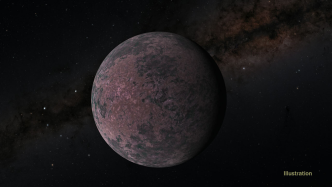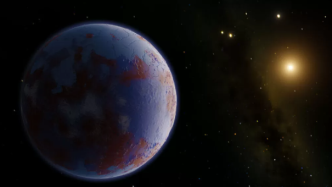

Rendering of the Earth-like planet without atmosphere GJ 1252b
American scientists have discovered an atmosphereless Earth-like planet GJ 1252b orbiting an M-type red dwarf star. The lack of an atmosphere means life is unlikely to survive on it. Given that M-type red dwarfs are the most common type of stars in the universe, the discovery promises to narrow the scope of scientists' search for extraterrestrial life. The research was published in the latest issue of The Astrophysical Journal Letters.
To determine that GJ 1252b has no atmosphere, UC Riverside astronomers measured the planet's infrared radiation when its light was blocked during a second solar eclipse. When a planet passes behind a star, the planet's light and its reflection from the star are blocked, creating a solar eclipse.
These infrared radiation revealed that GJ 1252b's scorching daytime temperature was estimated to be as high as 1,228 degrees Celsius, so much so that gold, silver and copper would all melt on the planet. The high temperature, coupled with the low surface pressure, led researchers to believe the planet had no atmosphere. Study co-author Stephen Kane said: "The planet may have 700 times the carbon content of Earth, but it still has no atmosphere. This carbon initially accumulates, but then gradually decreases and eventually disappears. In addition, with the sun In contrast, M-type red dwarfs tend to have more flares and are more active, further reducing the likelihood that the planets around them will retain atmospheres."
Studies have shown that GJ 1252b is slightly larger than Earth and is much closer to its star than Earth is to the sun, making it very hot and unsuitable for life to thrive. Study co-author Michelle Hill said: "The pressure created by the stellar radiation is so intense that it can blow the planet's atmosphere away."
Earth also slowly loses some of its atmosphere due to the sun, but volcanic eruptions and other carbon-cycling processes can make up for what's lost, making the loss of Earth's atmosphere less noticeable, the researchers explained. But planets closer to the star have not had such luck, like Mercury, which does have an atmosphere, but a very thin atmosphere composed of atoms stripped from the surface by the sun, and the extreme heat on the planet causes those atoms to escape into space.
But Hill also pointed out: "If a planet is far enough away from an M-type red dwarf star, its atmosphere may be preserved, and at present we cannot conclude that all rocky planets around M stars will suffer the fate of Mercury."
(Original title "Earth-like exoplanet without atmosphere "appears")
